Scottish Marine and Freshwater Science Volume 6 Number 10: At-Sea Turnover of Breeding Seabirds - Final Report to Marine Scotland Science
The aim of this project was to review the potential issue of "turnover‟ of individual seabirds at sea during the breeding season and to assess how this may lead abundance estimates derived from boat or aerial surveys to underestimate the total number of b
4. Results
4.1. Estimates of turnover
For each species we present graphs of the level of site fidelity () against estimated turnover for each of the four species and each of the five recently consented wind farm footprints (the footprints of the four individual wind farms, and the combined footprint of Alpha and Bravo). Turnover is estimated across multiple levels of site fidelity for each behavioural category (foraging, resting at sea, flying), for each spatial scale of fidelity (0.5 km*1.0 km; 10 km*10 km; 50 km*50 km).
The results are shown in Figures 4.1.1 to 4.1.20. As expected, as the level of site fidelity increases for each species and footprint (x-axis in each Figure) the corresponding estimate of turnover decreases. This is because as birds display more faithfulness to foraging sites the total number of foraging sites they visit within the breeding season decreases. This means that birds make more repeat visits to a survey area over the breeding season, so the proportion of the total population observed in a snapshot survey will increase, causing turnover to decrease.
This decrease in the estimate of turnover with increasing levels of site fidelity occurs less sharply as the spatial scale of site fidelity increases for all species and footprints (comparing the orange, red and blue lines in the Figures). This is because as the spatial area over which birds express site faithfulness increases, they are less likely to return to a foraging location within the spatial extent of the snapshot survey. Although birds are being site faithful, the spatial area of the 'site' ultimately becomes sufficiently large such that fidelity to the site does not equate to fidelity to the footprint ( i.e. they may return to the same "site", but nonetheless swap from being in a location that is within the footprint to one that is outside, or vice versa).
Turnover is generally much higher for commuting behaviour than for either foraging or resting. This is primarily because birds spend (according to empirical time activity budgets) a small proportion of their time each day commuting. However, it is also because the time that they do spend will be spread across a much wider spatial area than the time that they spend foraging or resting (so that site fidelity in terms of commuting will effectively be much lower than that for foraging or resting).
Uncertainty in turnover (captured by the confidence intervals on each Figure) is much lower for puffin than for the other three species (for which it is generally large). The reason for this is unclear: it may be because the estimated foraging locations of puffin are more clustered spatially than for the other species, or it may be an artefact (possibly relating to the very small amounts of GPS data that were used to construct the estimated foraging density maps for puffin).
The estimates of turnover, and associated confidence intervals, do not always decay as site fidelity increases. We suspect that this simply reflects stochastic variation between sets of simulated locations. The effect is most pronounced for Bravo - this is likely to be due to high levels of both stochasticity and spatial heterogeneity associated with this footprint (the stochasticity relates to the fact that relatively few birds actually visit this footprint, leading to noise in the resulting estimates of turnover; the heterogeneity relates to the presence of a bird density "hot spot" on the edge of the Bravo footprint).
Figure 4.1.1: Plot of fidelity against turnover for kittiwake in relation to the Inchcape footprint. Colours denote the spatial scale at which site fidelity is assumed to operate (0.5 x 1 km: blue; 10 x 10 km: red; 50 x 50 km: orange). 95% confidence intervals are shown as dotted lines.
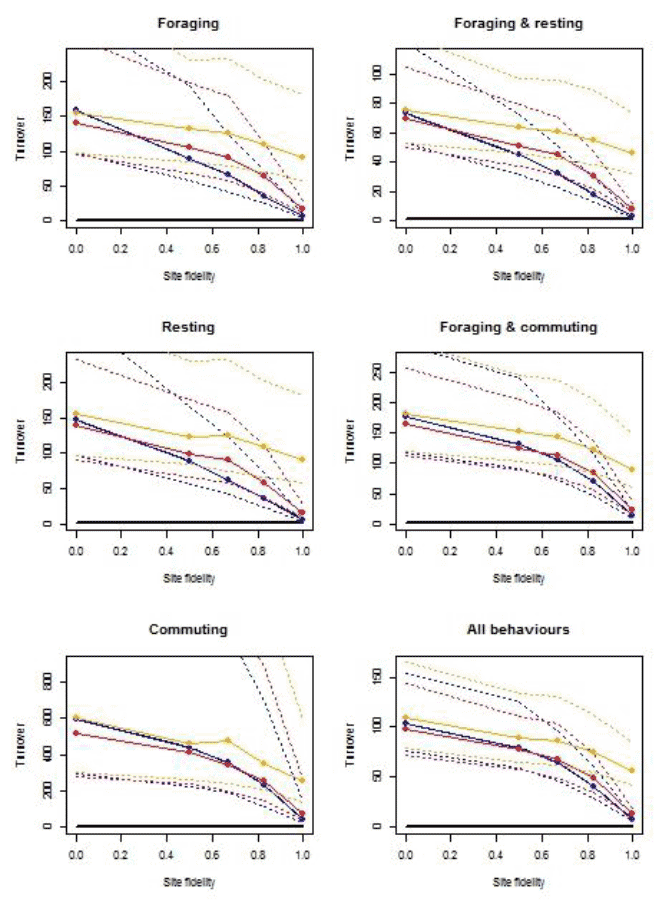
Figure 4.1.2: Plot of fidelity against turnover for kittiwake in relation to the NnG footprint. Colours denote the spatial scale at which site fidelity is assumed to operate (0.5 x 1 km: blue; 10 x 10 km: red; 50 x 50 km: orange). 95% confidence intervals are shown as dotted lines.
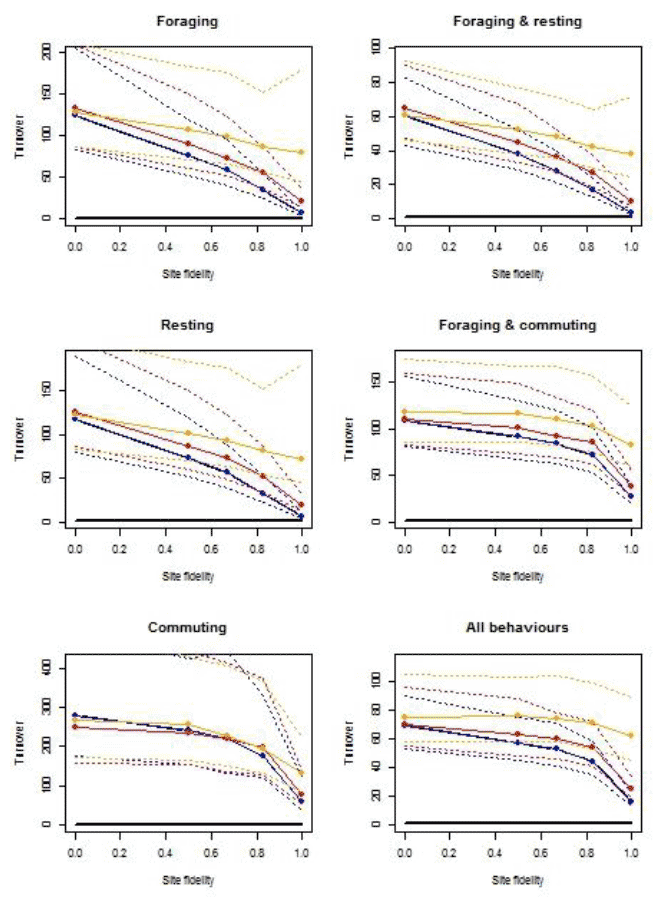
Figure 4.1.3: Plot of fidelity against turnover for kittiwake in relation to the Alpha footprint. Colours denote the spatial scale at which site fidelity is assumed to operate (0.5 x 1 km: blue; 10 x 10 km: red; 50 x 50 km: orange). 95% confidence intervals are shown as dotted lines.
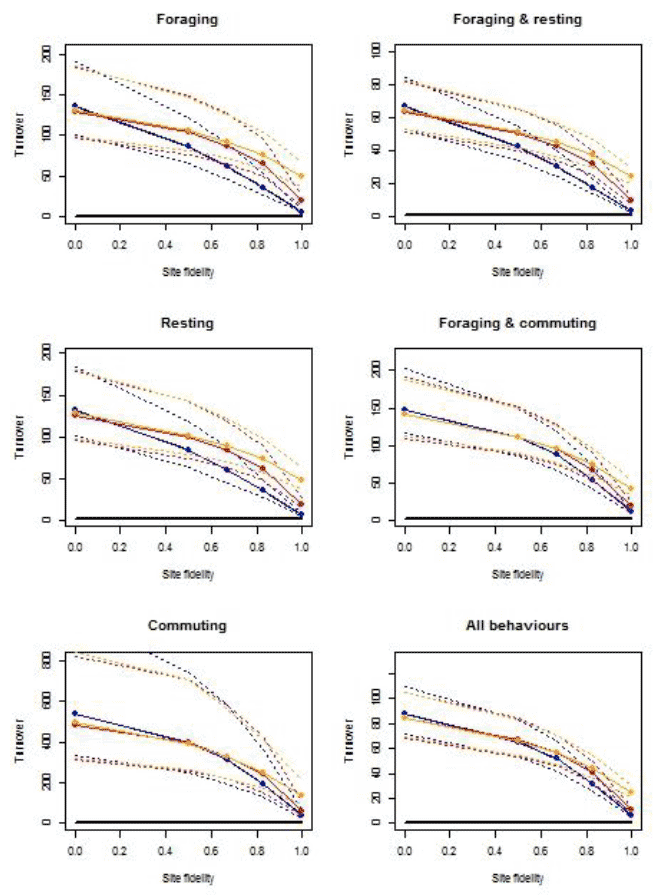
Figure 4.1.4: Plot of fidelity against turnover for kittiwake in relation to the Bravo footprint. Colours denote the spatial scale at which site fidelity is assumed to operate (0.5 x 1 km: blue; 10 x 10 km: red; 50 x 50 km: orange). 95% confidence intervals are shown as dotted lines.
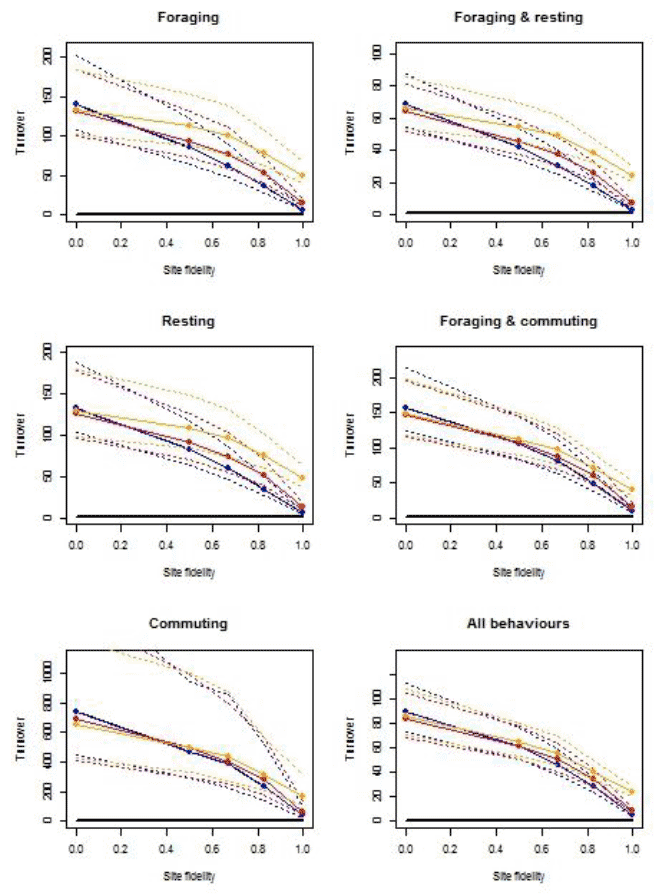
Figure 4.1.5: Plot of fidelity against turnover for kittiwake in relation to the combined Alpha-Bravo footprint. Colours denote the spatial scale at which site fidelity is assumed to operate (0.5 x 1 km: blue; 10 x 10 km: red; 50 x 50 km: orange). 95% confidence intervals are shown as dotted lines.
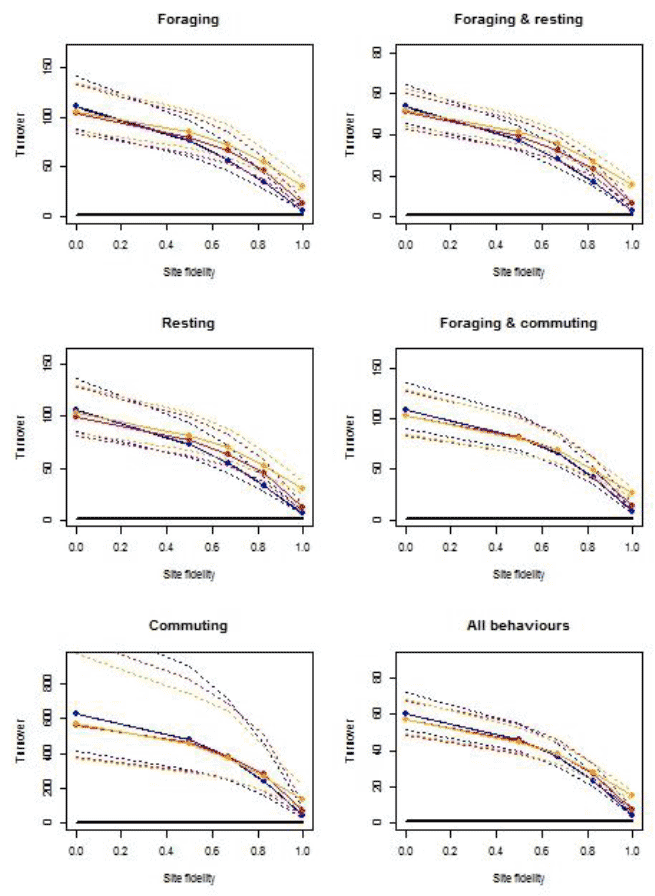
Figure 4.1.6: Plot of fidelity against turnover for guillemot in relation to the Inchcape footprint. Colours denote the spatial scale at which site fidelity is assumed to operate (0.5 x 1 km: blue; 10 x 10 km: red; 50 x 50 km: orange). 95% confidence intervals are shown as dotted lines.
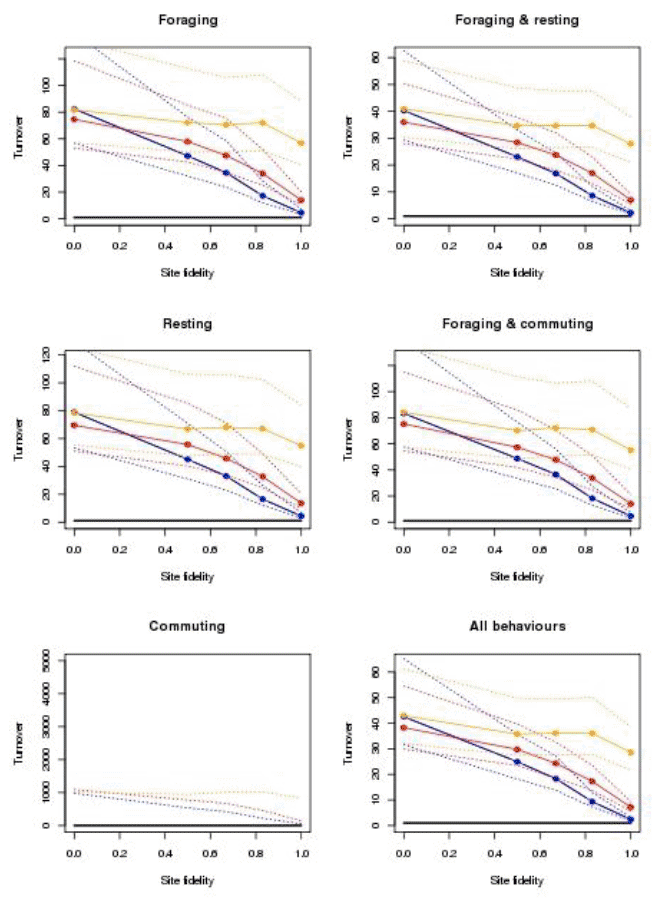
Figure 4.1.7: Plot of fidelity against turnover for guillemot in relation to the NnG footprint. Colours denote the spatial scale at which site fidelity is assumed to operate (0.5 x 1 km: blue; 10 x 10 km: red; 50 x 50 km: orange). 95% confidence intervals are shown as dotted lines.
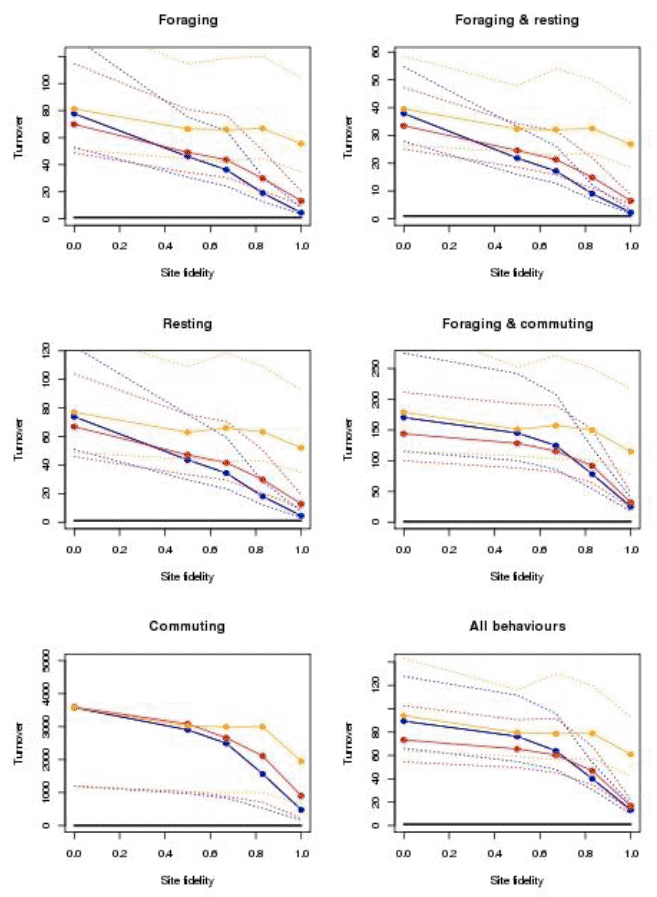
Figure 4.1.8: Plot of fidelity against turnover for guillemot in relation to the Alpha footprint. Colours denote the spatial scale at which site fidelity is assumed to operate (0.5 x 1 km: blue; 10 x 10 km: red; 50 x 50 km: orange). 95% confidence intervals are shown as dotted lines.
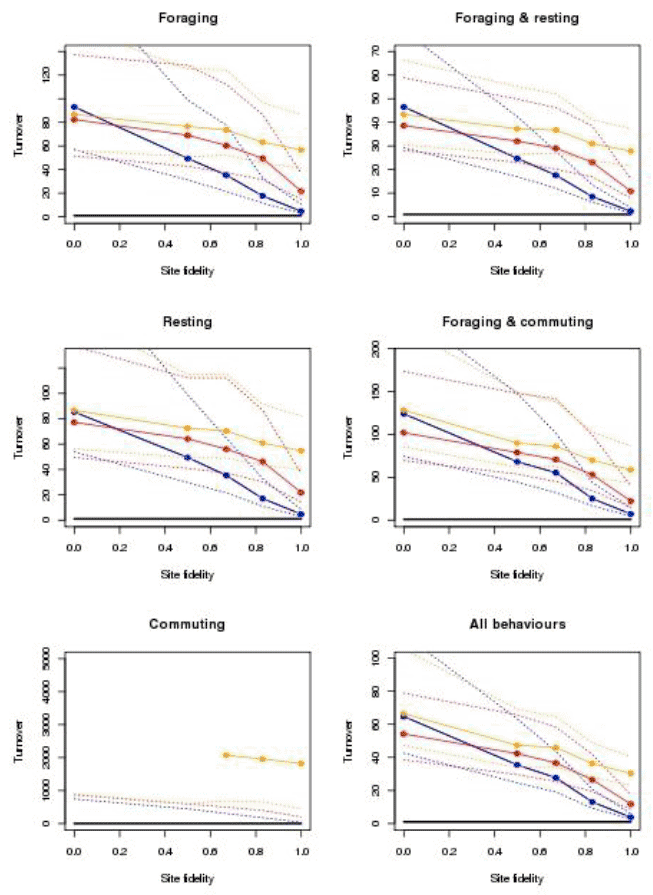
Figure 4.1.9: Plot of fidelity against turnover for guillemot in relation to the Bravo footprint. Colours denote the spatial scale at which site fidelity is assumed to operate (0.5 x 1 km: blue; 10 x 10 km: red; 50 x 50 km: orange). 95% confidence intervals are shown as dotted lines.
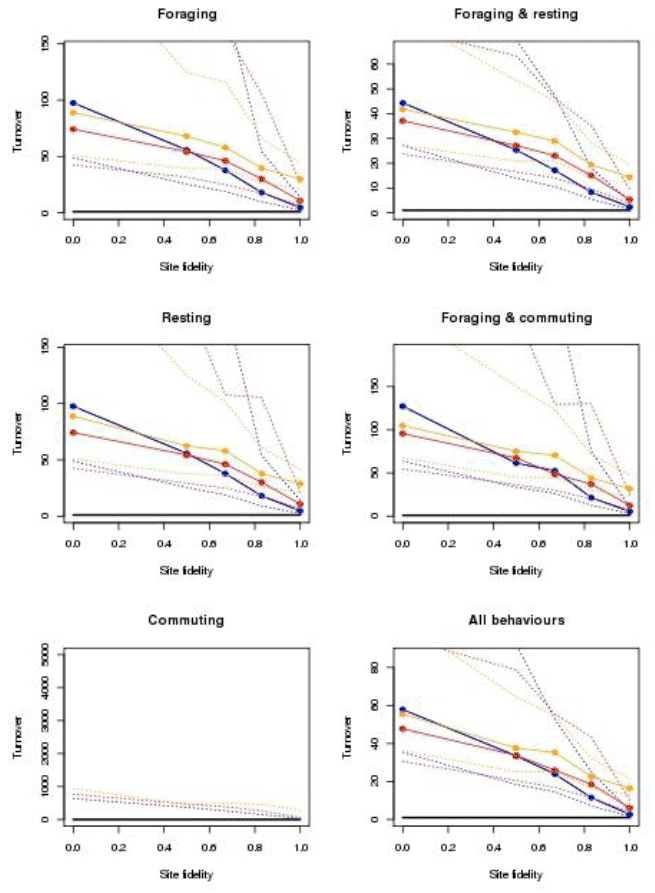
Figure 4.1.10: Plot of fidelity against turnover for guillemot in relation to the combined Alpha-Bravo footprint. Colours denote the spatial scale at which site fidelity is assumed to operate (0.5 x 1 km: blue; 10 x 10 km: red; 50 x 50 km: orange). 95% confidence intervals are shown as dotted lines.
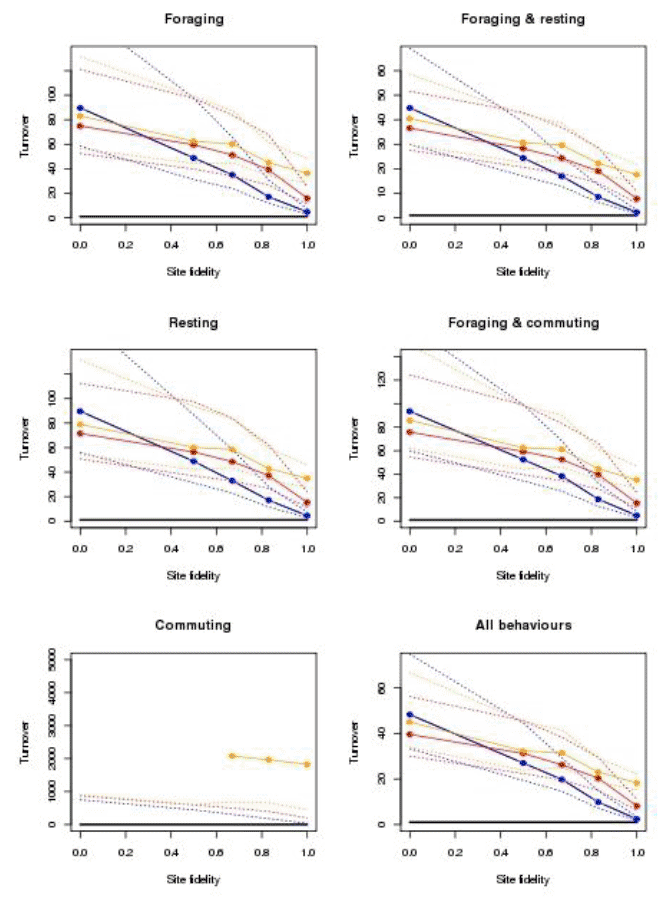
Figure 4.1.11: Plot of fidelity against turnover for razorbill in relation to the Inchcape footprint. Colours denote the spatial scale at which site fidelity is assumed to operate (0.5 x 1 km: blue; 10 x 10 km: red; 50 x 50 km: orange). 95% confidence intervals are shown as dotted lines.
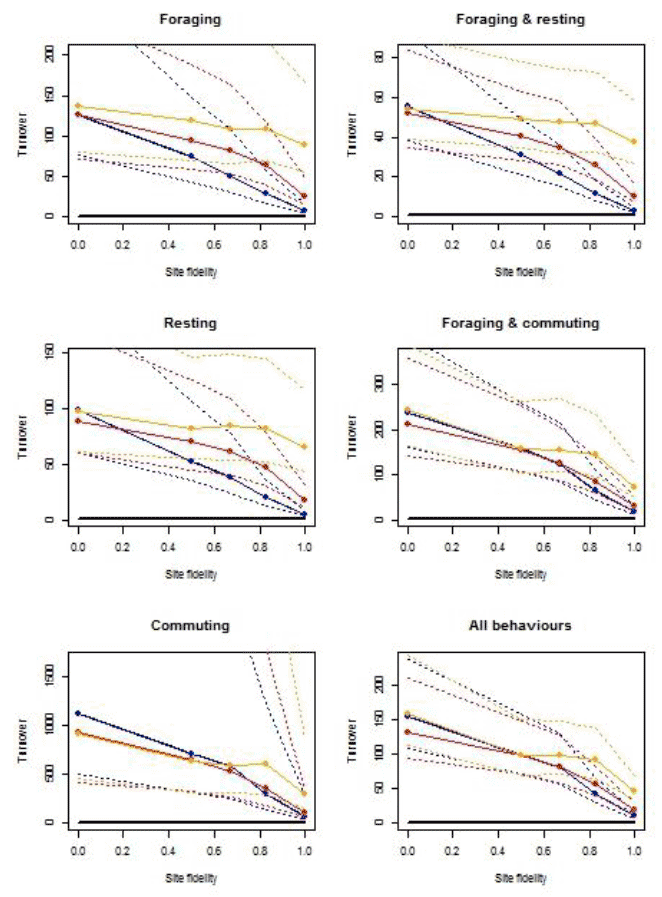
Figure 4.1.12: Plot of fidelity against turnover for razorbill in relation to the NnG footprint. Colours denote the spatial scale at which site fidelity is assumed to operate (0.5 x 1 km: blue; 10 x 10 km: red; 50 x 50 km: orange). 95% confidence intervals are shown as dotted lines.
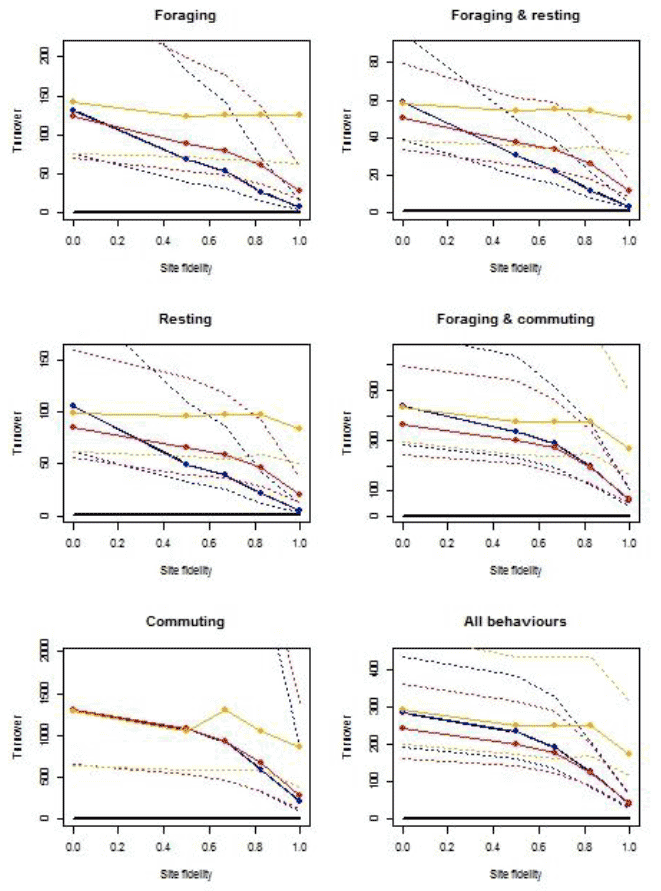
Figure 4.1.13: Plot of fidelity against turnover for razorbill in relation to the Alpha footprint. Colours denote the spatial scale at which site fidelity is assumed to operate (0.5 x 1 km: blue; 10 x 10 km: red; 50 x 50 km: orange). 95% confidence intervals are shown as dotted lines.
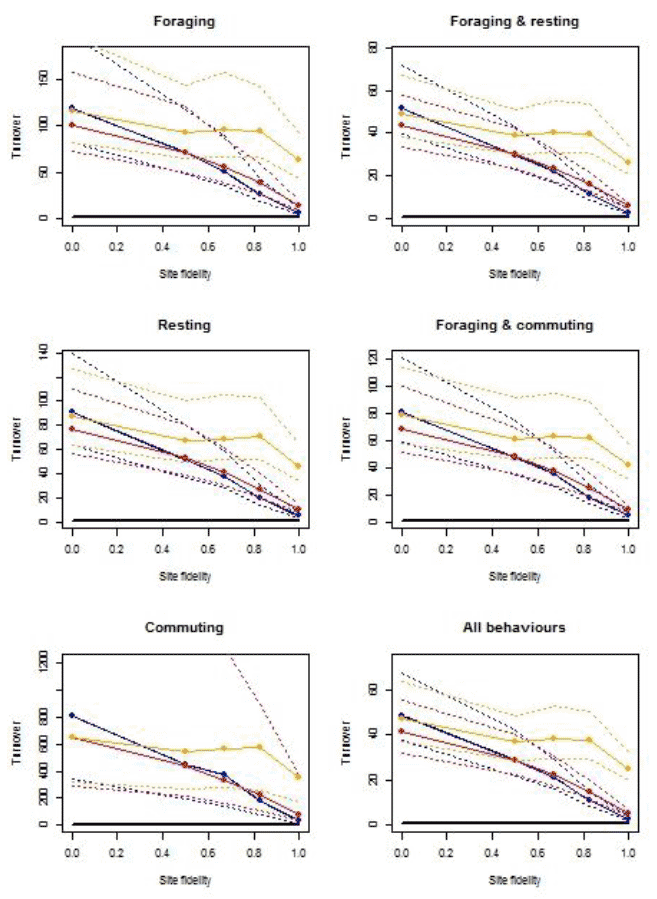
Figure 4.1.14: Plot of fidelity against turnover for razorbill in relation to the Bravo footprint. Colours denote the spatial scale at which site fidelity is assumed to operate (0.5 x 1 km: blue; 10 x 10 km: red; 50 x 50 km: orange). 95% confidence intervals are shown as dotted lines.
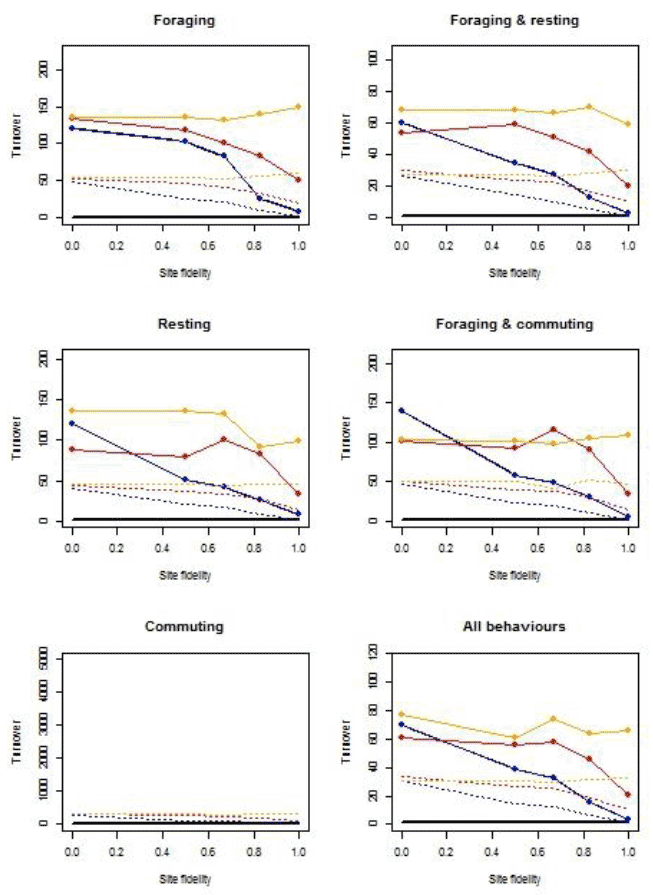
Figure 4.1.15: Plot of fidelity against turnover for razorbill in relation to the combined Alpha-Bravo footprint. Colours denote the spatial scale at which site fidelity is assumed to operate (0.5 x 1 km: blue; 10 x 10 km: red; 50 x 50 km: orange). 95% confidence intervals are shown as dotted lines.
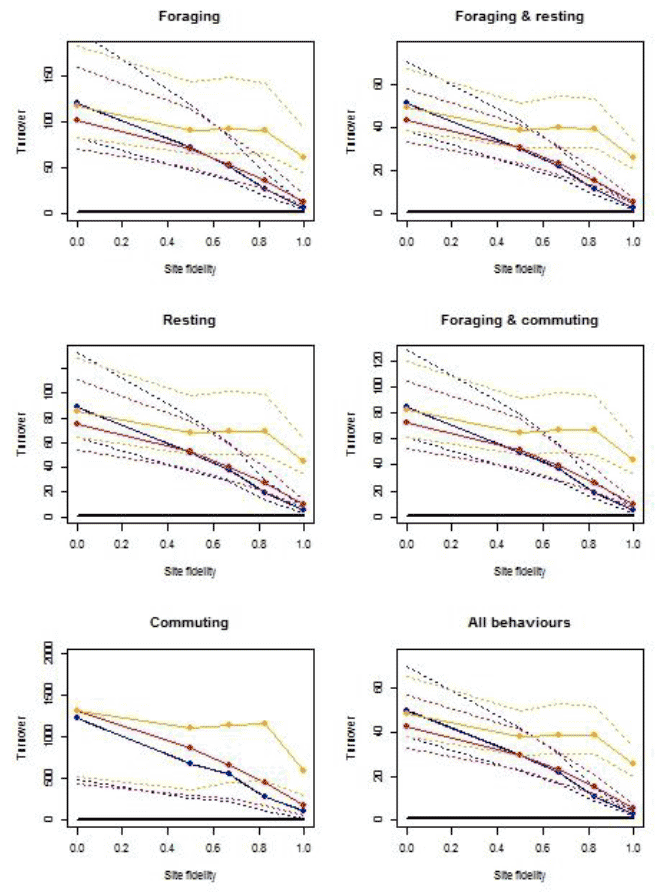
Figure 4.1.16: Plot of fidelity against turnover for puffin in relation to the Inchcape footprint. Colours denote the spatial scale at which site fidelity is assumed to operate (0.5 x 1 km: blue; 10 x 10 km: red; 50 x 50 km: orange). 95% confidence intervals are shown as dotted lines.
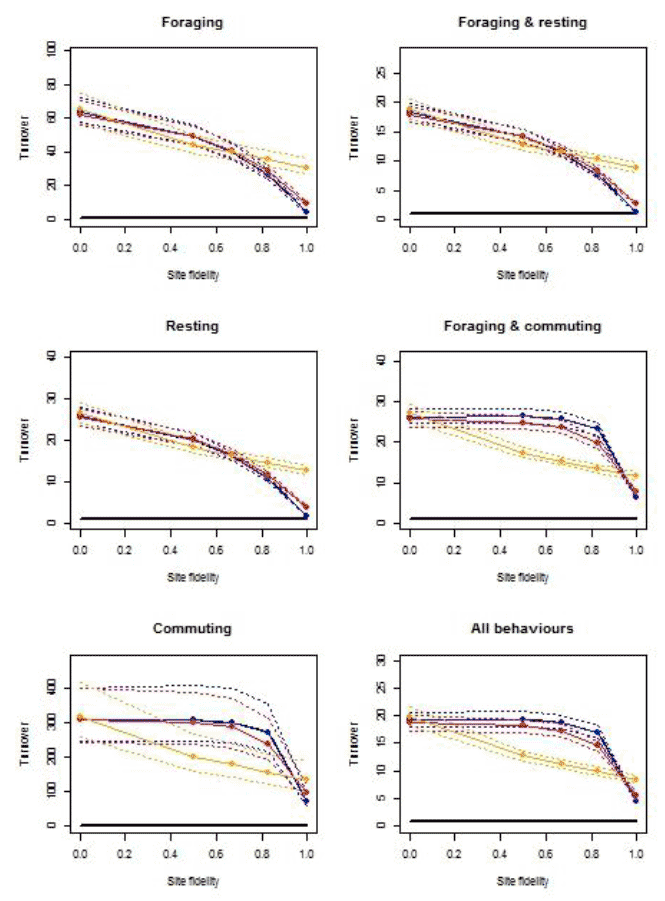
Figure 4.1.17: Plot of fidelity against turnover for puffin in relation to the NnG footprint. Colours denote the spatial scale at which site fidelity is assumed to operate (0.5 x 1 km: blue; 10 x 10 km: red; 50 x 50 km: orange). 95% confidence intervals are shown as dotted lines.
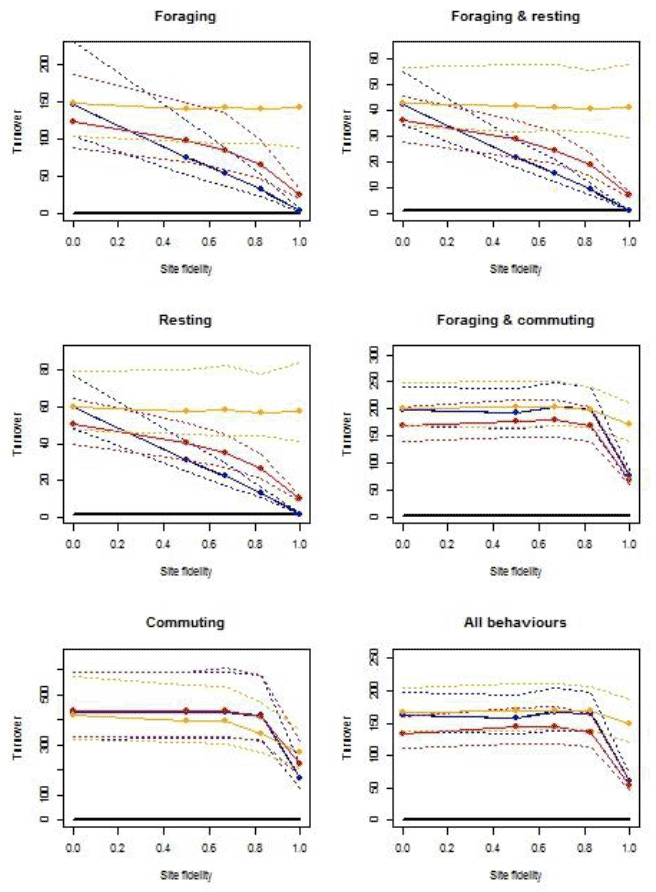
Figure 4.1.18: Plot of fidelity against turnover for puffin in relation to the Alpha footprint. Colours denote the spatial scale at which site fidelity is assumed to operate (0.5 x 1 km: blue; 10 x 10 km: red; 50 x 50 km: orange). 95% confidence intervals are shown as dotted lines.
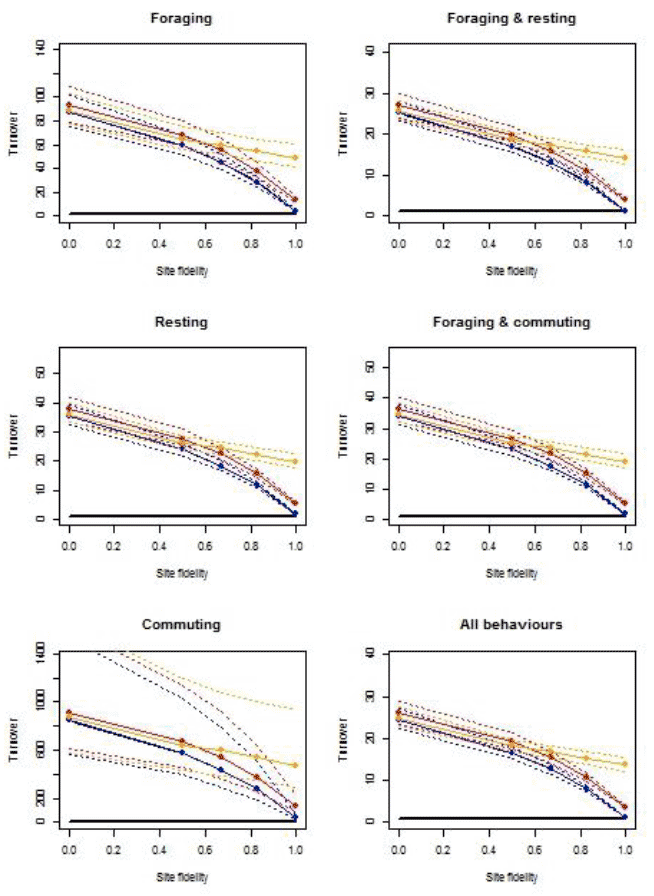
Figure 4.1.19: Plot of fidelity against turnover for puffin in relation to the Bravo footprint. Colours denote the spatial scale at which site fidelity is assumed to operate (0.5 x 1 km: blue; 10 x 10 km: red; 50 x 50 km: orange). 95% confidence intervals are shown as dotted lines.
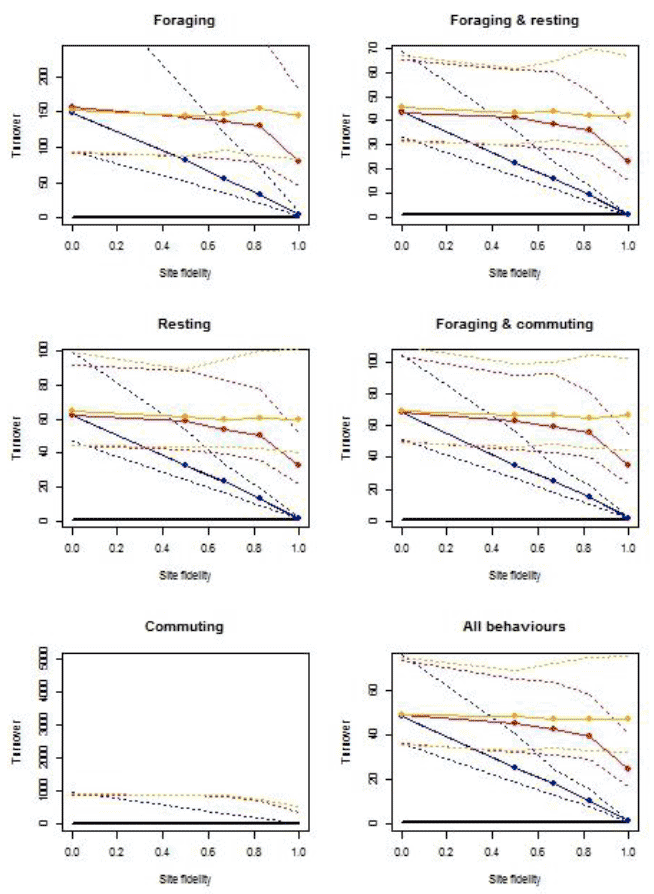
Figure 4.1.20: Plot of fidelity against turnover for puffin in relation to the combined Alpha-Bravo footprint. Colours denote the spatial scale at which site fidelity is assumed to operate (0.5 x 1 km: blue; 10 x 10 km: red; 50 x 50 km: orange). 95% confidence intervals are shown as dotted lines.
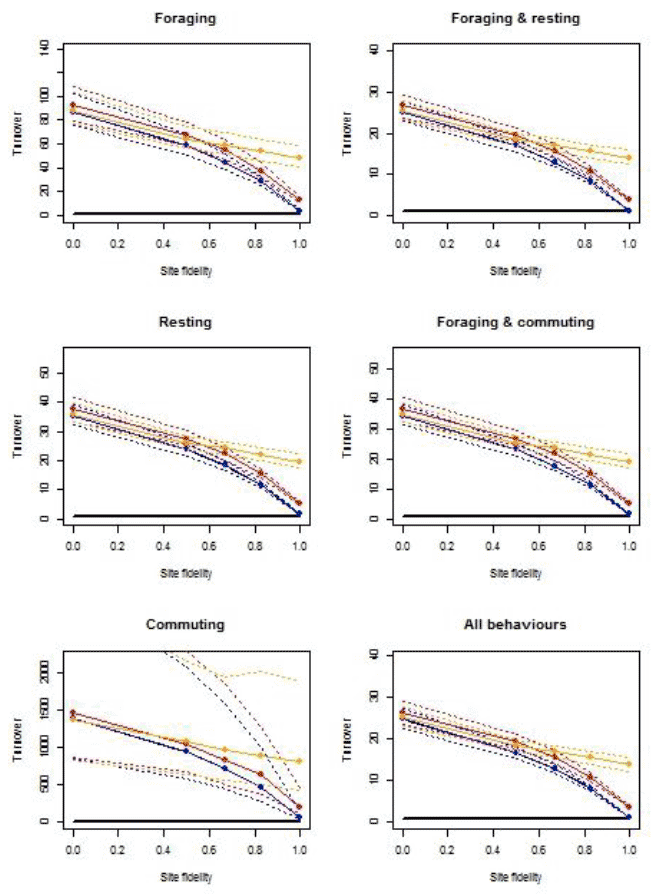
4.2. The Influence of Footprint Size on Turnover
The above exercise was repeated, but using four 'artificial' wind farm footprints (10 km 2, 40 km 2, 100 km 2 and 200 km 2) that were each centred on the geographical centre of the five recently consented wind farm footprints.
For computational reasons this analysis was only run for one behaviour (foraging), one level of fidelity (0.5) and one spatial scale of fidelity (5 km x 5 km). The results are complicated and relatively noisy, but generally show a tendency for turnover to decrease as the footprint area increases.
Similarly, as the footprint area increases and snapshot surveys are conducted over a larger spatial extent, the estimate of turnover decreases (Figures below). Again, this is simply because as the areal extent of the survey increases it will capture a greater number of birds, so the proportion of the total population observed in the survey window increases. Differences in this relationship between the different wind farm footprints are simply due to differences in the estimated density of birds over the region or to the distance to colony.
Figure. 4.2.1: Graph of the scale of the wind farm footprint area against turnover for each of the four species, foraging within each of the recently consented wind farm footprints (represented by successively larger 'artificial' footprints). The five colours represent Inch Cape (red), Neart na Gaoithe (blue), Round 3 Alpha and Bravo combined (green), Round 3 Alpha (purple), and Round 3 Bravo (orange). 95% confidence intervals are shown as dotted lines.95% confidence intervals are also shown (dotted) for each relationship.
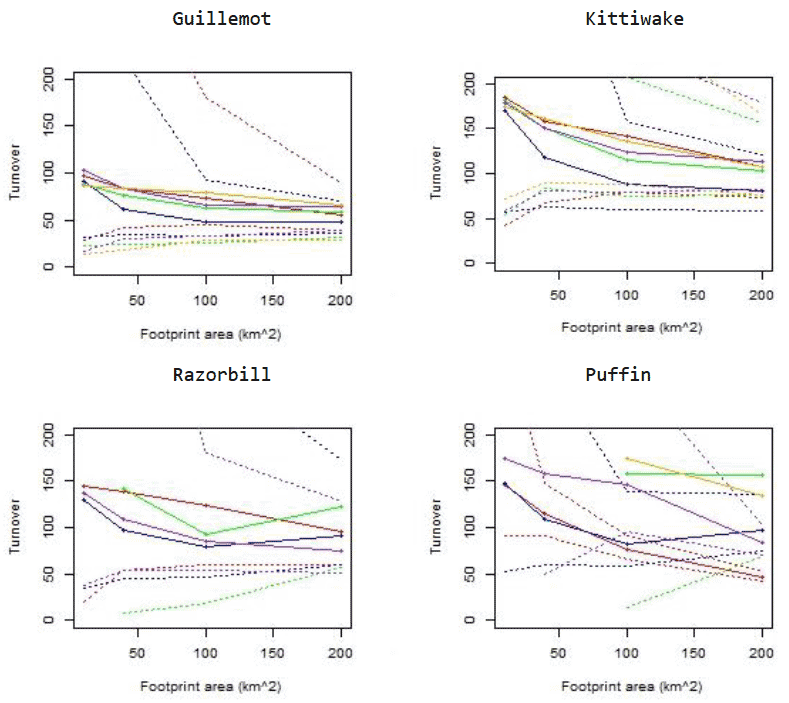
Contact
There is a problem
Thanks for your feedback